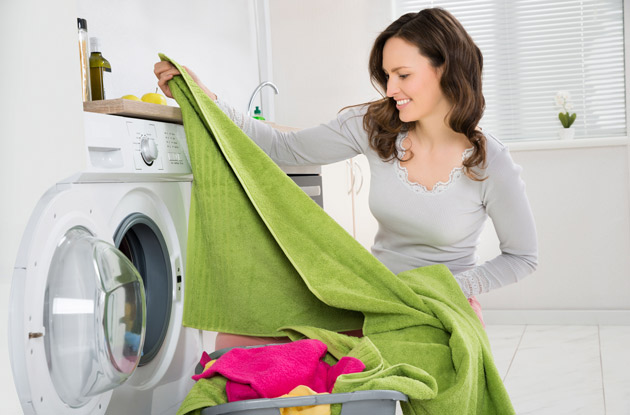
27 Places in Your Home You Might Be Forgetting to Clean
These spots in your home should be cleaned on a regular basis, plus a few insider tip and tricks
Get can’t-miss family activities sent to you!
Get the Best Kid-Friendly Activities
Sent to You Weekly!
Spots Commonly Missed in Common Areas
Ceiling fans: The tops of the fan blades can get particularly dusty—out of sight, out of mind. When I moved into my first apartment in New York City, my dad, who sees all those out-of-sight places because he’s 6-foot-4, wiped down the fan blades in my room—and you wouldn’t believe the amount of caked-on dust that came off. I only wish I had known Ireland’s trick: Every few months, dampen a pillowcase, put it over each blade so the fan blade is encased, and slide the pillowcase off so the dust stays inside the pillowcase.
Pet food bowls: If you feed your dog or cat wet food, chances are you regularly wash their bowls to clean off dried-on food. But what about dry food bowls? “A lot of times people have dogs where the food never gets eaten all the way or the cat food is always in there, so it’s nice if once a week you can wash them with soapy water, rinse them, and sanitize them,” Gagliardi advises.
Houseplants: We don’t typically think of plants getting dusty, but they do. “We tend to overlook them until we notice them, and we tend to brush the dust off with our hands, but the oil from our hands is not friendly to plants,” Ireland says. So use a water-dampened cloth when you do your regular dusting, or regularly spray your plants.
Points of contact: We’re talking all over the house here. Bathroom and kitchen cabinet handles, doorknobs, light switches, remote controls, tablets, phones, anything you and your family touch on a daily basis. These points of contact are how germs are transferred from person to person, so these are areas to be particularly mindful about cleaning, Maker says. “You can take a disinfectant and spray those points of contact as long as they don’t have electricity associated with them, you can let that product sit for a minute or two, and then wipe it,” she says. If the point of contact does have an electric component, Maker suggests spraying a cloth with a cleaner or rubbing alcohol and wiping it down.
Litter boxes: While we regularly clean out the litter boxes and refresh the litter, how often do we actually wash the litter box? Probably not often enough. “We have a recommendation for deodorizing litter boxes, where you remove the cat litter and clean the litter box with soapy water, let it soak with a half cup of bleach per gallon of water for five minutes, and rinse it and let it air dry,” Gagliardi suggests. “Put the cat litter back in and that will keep litter boxes smelling much, much better.”
Baseboards, crown molding, and heat registers / return vents: Dust builds up on these. Weinstock, Maker, and Gagliardi all suggest vacuuming them a few times a year with the brush attachment—or stay on top of it by cleaning them every time you vacuum the carpets.
RELATED: What are the best ways to clean my carpets?
Spots Commonly Missed in the Kitchen
Overhead exhaust: The purpose of the overhead exhaust is to suck the greasy vapor out of your kitchen, according to Maker. “On its way up, the vapor leaves behind a significant amount of grease, and as it builds up, it becomes sticky, it becomes rancid, and you really do need to give it a good clean,” she says. Maker recommends you fill up a bucket with hot water and a scoop of oxygen bleach powder, soak it for about 10 minutes, dry it, and put it back up. You may need to give it a bit of a scrub, she cautions.
Potholders: “People never wash those, and they don’t necessarily hold up well to washing,” Gagliardi says. “But if they’re so dirty that you shouldn’t be using them anyway and you wash them and they don’t necessarily have good dimensional stability, then it was time to replace them.” Just be careful when laundering potholders, as they tend to bleed color. Soak them in water first to see how much color runs off; that way you won’t have dye transfer onto other items, Gagliardi advises.
Under the sink: This area tends to become a hotspot for junk, cleaning products, plastic shopping bags, and sometimes bits of trash that miss the garbage can (that is, if you keep the garbage can under the sink). So every now and then, dive in and take everything out, give it a good wipe, and, as Maker recommends, “put in a shelf liner because it can become very wet under there and you can ruin the base of the cabinet.” Then put back only the items you need. Now that we think about it, tackle the cabinet under the sink in the bathroom, too.
Garbage cans and recycling bins: We all regularly take out the garbage and recycling—at the very least when it’s trash day—but cleaning the receptacles themselves is often left undone. Gagliardi suggests disinfecting these once a month, especially if drink cans aren’t rinsed out before going in there. To keep them disinfected and deodorized, she suggests washing them with soapy water, then letting them soak in a solution of ½ cup of bleach per ¾ gallon of water for 5 minutes, rinsing it, and letting it air dry. Alternatively, Ireland suggests using a trash can as a bucket when mopping the floors, which will clean it too.
Inside the microwave: When food is nuked in the microwave, it can splatter, “and most people will leave it for a week, but would you leave food stains or dried up food on your counter for a week? Probably not,” Dimmick says. She suggests cleaning the microwave daily with a mixture of vinegar and water. Meanwhile Weinstock suggests heating up water in the microwave to create a steam, which will loosen up caked-on food, making it easier to wipe off.
Sponges: These can get smelly fast. Rather than throwing them out frequently, every time you run your dishwasher, Gagliardi suggests tossing them in, too. And for a deeper clean, she says you can soak them in a solution of ½ cup of bleach per gallon of water for 5 minutes, rinse them, and let them air dry. For a cleaning double-whammy, get your sponge wet and microwave it on high for 2 minutes, then carefully remove it. This deodorizes and disinfects your sponge, Ireland says, and the steam makes it easier to clean the microwave.
The warming drawer in the oven: People tend to use this little drawer under the oven as storage for baking sheets and think nothing of it since it’s not being used for food. But if you remove everything, “you’ll see it’s just full of crumbs, so every now and then its important to take everything out,” Maker says. “You can use the brush attachment on the vacuum to clean it out, and once you vacuum out the crumbs, spray it and wipe it out, and replace only the items you need.”
Coffee pot and coffee grinder: Ireland suggests these be cleaned once a month. Run the coffee maker with a solution that is 1 part vinegar and 4 parts water. Then, for insulated coffee urns that are difficult to clean, he suggests dropping a denture-cleaning tab in with some hot water and letting that sit overnight, while regular pots can be hand washed with dish soap. And put a handful of uncooked rice in the grinder and grind it. This will clean the blades without needing to get it wet.
Refrigerator: “You can still grow bacteria in there even though it’s cold,” Dimmick says. So she cleans out her fridge once a week. “It’s also a great time to do a deep dive and look at the expiration dates on condiments,” she adds. And make sure to get under the crisper drawers. “We spend a lot of time trying to keep odors out of the refrigerator, but a lot of times there’s stuff under the crisper drawers,” Ireland adds.
With all of this in mind, Weinstock suggests creating a cleaning routine or schedule that is doable for you. “Try to get in the habit of doing certain tasks every day: sweeping, doing the dishes, wiping the counters,” she says. “And then set aside the time to actually clean, otherwise it gets so overwhelming.”
RELATED:
Getting Creative with Chores Will Get Kids Hooked




.png.jpg)



